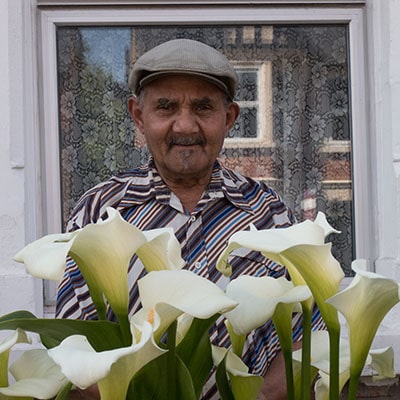Lord Muck's Blog
June 27, 2019
Liss Ard House, just outside Skibbereen in west Cork has a curious place in the myths and legends that go to make up my family history. My grandfather Abraham Hegarty left the Skibbereen area to join the Royal Navy as a ‘boy second class’ in 1892, recommended by the local squires the Somerville’s of Castletownshend, a village described to me recently as ‘the most English village in Ireland’. The graveyard of the Church of Ireland church that dominates the village attests to its anomalous position, filled with monuments to Chavasse’s, Townshend’s, Somerville’s and Ross’s, almost all very senior British military figures, as well as the joint grave of Edith Somerville and Violet Florence Martin (who wrote under the pseudonym Martin Ross) the couple, in life as well as in literature, who wrote ‘The Irish RM’ series of books.
Abraham fought in WW1 and retired after 30 years service, rising to the rank of Lieutenant Commander; but after that kind of career he was never going to return to live in a newly independent Ireland. One of the Somerville’s was assassinated by the IRA as late as 1936. But he did return occasionally to see family, and the story is that when he did, he stayed at Liss Ard. This seemed unlikely to me when all his relatives were poor farmers around Castlehaven and Toe Head. But one was not so poor, as Lord and Lady Muck discovered on a visit earlier in the month. John Connolly and his wife Mary Ellen bought Liss Ard in 1924. John Connolly ‘s brother Tim married Abraham’s sister Annie – so why wouldn’t a recently retired Royal Navy officer stay in the local ‘big house’ with his (sort of) in-laws when back visiting. Connolly though has a dark reputation in the Hegarty family. Allegedly his money was made by ruthlessly evicting people including his relatives, from their farms after getting them to sign away their property having got them drunk. Stories that make the visit to see the James Turrell-designed ‘Sky Garden’ at Liss Ard all the more intriguing.
In fact the Connolly connection with Liss Ard ended with John’s death in 1947. But the estate has had plenty of colourful episodes in its history since, including being bought by the Swiss Government, without their knowledge, by a rogue spy-master who was sacked for his trouble, as a putative location for a Government-in-exile in the event of a nuclear war in central Europe, in the 1970s. A German art dealer Veithe Turske bought the place in 1989, and in 1990 the development of the Sky Garden began. Turrell, an American known as a ‘land artist’ has work all over the world, and the scale of some of the installations is massive. He has been working on the Roden Crater in Arizona since 1979. The vision for Liss Ard was no exception. Following his first visit to Liss Ard in 1989 Turrell set to work to design three main spaces; the Crater, the Mound and the Pyramid. Work on the Crater began in early 1992. Things didn’t go to plan and only the Crater, aka ‘Sky Garden’ was ever completed, though the Liss Ard Foundation (now defunct) published a chunky book of essays, drawings, photo montages and pictures of models of the whole project. Following more recent incarnations as a rock venue, and organic gardening centre, Liss Ard is now rather prosaically a boutique hotel, wedding and conference venue – with a Sky Garden.
So to the Sky Garden we proceeded one rather blustery and cloudy day. The drive up to the big house is probably the longest I have ever experienced, and the house itself is expensively decorated, including a grand piano allegedly played by various ‘rock gods’ including Nick Cave and Patti Smith, set about with outbuildings, now turned into hotel rooms, a charming garden of the stately home variety with ha-ha and horses grazing peacefully beyond, and the biggest Cedar of Lebanon tree we had ever seen. If only things had turned out differently it could have made a grand seat for Lord and Lady Muck.
But the Sky Garden itself called. It is a bit of a walk from the house through a portal-style gateway in a high stone wall, down a long flight of steps and through some woodland. Then suddenly a huge edifice looms. Having paid the 5 Euro entrance fee and being issued with the combination lock code we shot the bolt on the metal gate and were told to lock it behind us. Only two people allowed in at a time. Once inside, the ‘garden’ itself is accessed via a narrow limestone-walled passage lit from above by a small glazed light funnel, up some steep steps described by a local newspaper as ‘a birthing parallel’ and into the light, or starry skies depending on the time of the visit, of the garden itself. The first impression is of vertiginously steep sides to the grass-covered crater which had recently been mown. Second impression is that there are some pretty large holes in the turf. The Irish climate is a lot wetter than Arizona and this may not have been accounted for in the design. There is a sense of the steep sides slipping towards the centre of the crater with the passage of time and the depredations of the elements. In the centre is a plinth made from black granite. It is designed for two people to lie on (no, not making love) toe-to-toe, head resting on a small granite pillow below the level of the rest of the body. Open your eyes and look up.
The first impression is of vertiginously steep sides to the grass-covered crater which had recently been mown. Second impression is that there are some pretty large holes in the turf. The Irish climate is a lot wetter than Arizona and this may not have been accounted for in the design. There is a sense of the steep sides slipping towards the centre of the crater with the passage of time and the depredations of the elements. In the centre is a plinth made from black granite. It is designed for two people to lie on (no, not making love) toe-to-toe, head resting on a small granite pillow below the level of the rest of the body. Open your eyes and look up.  The view is disorientating. Almost at the edge of the field of view is the top of the crater and above, the sky. On a clear night the view would be stunning – the sky a myriad of bright stars and celestial objects, framed by the blackness of the grass crater. On a sunny day the patterns of clouds and their ever-shifting configurations would be a joy to behold – though not that different from lying flat on a sloping beach. But today the sky was uniformly grey; more Skegness from a bus shelter on the prom in mid-February than a mystical revelation on the edge of the Sahara at night. Nonetheless we stayed and stared.
The view is disorientating. Almost at the edge of the field of view is the top of the crater and above, the sky. On a clear night the view would be stunning – the sky a myriad of bright stars and celestial objects, framed by the blackness of the grass crater. On a sunny day the patterns of clouds and their ever-shifting configurations would be a joy to behold – though not that different from lying flat on a sloping beach. But today the sky was uniformly grey; more Skegness from a bus shelter on the prom in mid-February than a mystical revelation on the edge of the Sahara at night. Nonetheless we stayed and stared.
As we descended the stairs and unlocked the gate we found a young Dutch couple waiting their turn. As we sat on a bench beside a nearby pond munching our sandwiches they re-appeared in short order. The sky had not moved for them.
Wending our way back back thought the wooded glades and occasional stands of exotic trees, we stumbled upon an abandoned tennis court. Ferns and rhodedendrons crowded in upon it, trees overhung it, a thick layer of moss coverd the once pristine surface; there was an eerie stillness, a sense than maybe a terrible crime had been committed one evening long ago, and that nobody had dared approach it ever after. The curse of the Connolly’s? Hurrying on through the dank undergrowth of the woodland we suddenly burst upon the formality of the hotel gardens with their rattan tables and chairs set looking out over the horses and park land waiting for guests to partake of afternoon tea, almost as if the mysteries in the woods and the Sky Garden had never existed.
May 20, 2019
Urban front gardens can be a bit of a problem. The traffic noise and fumes, the small size (generally) and the sense that they are really just a space you pass through on your way to and from your front door, or a place to park the car.
But they are also, or can be, a statement of intent. Is this somewhere to store the bins, allow rubbish to accumulate – everything from abandoned needles to abandoned matresses as some front gardens do, or does it reflect something about the care lavished on the rest of home and garden or indeed – this being both private and public space, the attitude towards the neighbourhood? There are plenty of examples of all these approaches on the street that Lord Muck calls home. Indeed it is an extremely diverse and transient street – and a long one. Its thirty odd year since the Muck’s moved in, and the front garden has gone through a fair few of these stages – some of them at the same time. The time when the front of the house fell off due to subsidence early on (in 1989) and had to be taken down and rebuilt was another important factor. As the builders put it at the time, ‘There is enough concrete under that structure now to support a five story block of flats, let alone a bay window’. Planting things in concrete has never been the easiest of things to manage. The front garden wasn’t completely unloved; the hedge survived the builders and looked pretty, and large wooden tubs filled with dahlias and allium brightened things up considerably,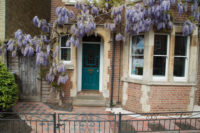 as did the glorious wisteria trailing all over the front of the house in the spring, but it suffered from ‘the neighbourhood’; smaller terracotta pots disappeared before the unmoveable half barrels replaced them, the front gate was stolen and passing dogs (or their owners) often found the convenience of those red Victorian tiles well…a convenience.
as did the glorious wisteria trailing all over the front of the house in the spring, but it suffered from ‘the neighbourhood’; smaller terracotta pots disappeared before the unmoveable half barrels replaced them, the front gate was stolen and passing dogs (or their owners) often found the convenience of those red Victorian tiles well…a convenience.
The final straw was the hot summer of 2018. Heat reflected off the street, the front of the house and those aforementioned tiles conspired to make all but the wisteria (deep rooted) extremely stressed by summers end. The hedge began to not just wilt, but die. Time for a re-think. Getting the hedge out was a nasty shock. The heat probably contributed, but the real cause of the problem – honey fungus infection. It can spread through soils very rapidly and wisteria is very vulnerable to it. So a complete re-vamp and redesign looked like it was just in the nick of time, including the installation of deep impermeable membranes to protect the wisteria roots.
So spring has been a time to focus on the new. Oxford Garden Partners came up with a design and planting plan and April and May have seen it gradually take shape. Locally sourced paviers from Matthews of Chesham, repairs to the Victorian tiling, a series of small beds and the space is transformed.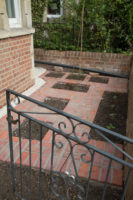 Instead of being a sometimes pretty but rather cramped, because of mass of hedge, transit area, it has suddenly opened up into something that feels like a new space, an outside room where perhaps on those quiet sunny Sunday mornings Lord and Lady Muck can partake of coffee and cakes and converse with neighbours and other passers-by
Instead of being a sometimes pretty but rather cramped, because of mass of hedge, transit area, it has suddenly opened up into something that feels like a new space, an outside room where perhaps on those quiet sunny Sunday mornings Lord and Lady Muck can partake of coffee and cakes and converse with neighbours and other passers-by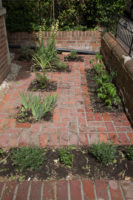 amidst the fragrance of herbs, lavender, irises, hydrangeas and daphne amongst others, that thrive in the warmth. An update at the end of the summer on how this idyll has played out beckons.
amidst the fragrance of herbs, lavender, irises, hydrangeas and daphne amongst others, that thrive in the warmth. An update at the end of the summer on how this idyll has played out beckons.
March 28, 2019
They say an army marches on is stomach. Last weekend’s million plus demonstration in favour of European unity and a People’s Vote on the outcome of the Brexit negotiations certainly suggests that large groups of demonstrators think the same way, if the placards to be seen on it were anything to go by. Lord Muck’s lens caught a positive feast, or at the very least tasting menu, of riffs on the food theme. Some of course made uncomplimentary comparisons between politicians and food: ‘Theresa eU turnip’ , ‘Theresa May is no Gouda’, ‘May contain nuts’
, ‘Theresa May is no Gouda’, ‘May contain nuts’ , ‘Eton Mess’ (a reference to the schooling of Johnson and Cameron) ‘Fromage not Farage’, while some were more generalised insults such as ‘Vegans against Gammon’.
, ‘Eton Mess’ (a reference to the schooling of Johnson and Cameron) ‘Fromage not Farage’, while some were more generalised insults such as ‘Vegans against Gammon’.
Cheese was a major theme. ‘Blessed are the (soft) cheese makers’ sounds rather wistful, ‘Don’t make me stockpile French cheese’ gets to the heart of the European project, while others preferred the pun ‘I Camembert to leave EU’ and ‘Feta together’ (recycled from the Scottish Indyref ?).
sounds rather wistful, ‘Don’t make me stockpile French cheese’ gets to the heart of the European project, while others preferred the pun ‘I Camembert to leave EU’ and ‘Feta together’ (recycled from the Scottish Indyref ?).
Puns were very much to the fore, ‘I’m stockpiling herbs in case of a no dill Brexit’, ‘Brexit couldn’t get much wurst’, ‘beef stock, chicken stock, laughing stock’ even stretching the puns right across a ‘full English Brexit’, including ‘has beans’ , ‘scrambled eggsit’ ‘we’re toast’ and ‘humble pie’. There was some pretty dark humour on show too: ‘eat my bleached chicken: drink my covfefe’ (thank you Mr Trump)
There was some pretty dark humour on show too: ‘eat my bleached chicken: drink my covfefe’ (thank you Mr Trump) or the even blunter ‘I don’t want to eat rats’.
or the even blunter ‘I don’t want to eat rats’.
Others were just plain surreal, ‘Brexit is like a cup of microwave tea, its just wrong’, ‘my father ate pies in peace’ a reference to the fact that grandparents had to fight in world wars, or the one Salvador Dali would have loved ‘Theresa cray cray’.  Mind you not as surreal as the code name given by the Government for their emergency food and medicine planning programme in the event of a ‘No deal’ Brexit; ‘Operation Yellowhammer’, a bird whose song, as Lady Muck, also on the march reminded me, is popularly rendered as ‘a little bit of bread and no cheese’. Perhaps those placard-wavers worried about their cheese supplies were on to something.
Mind you not as surreal as the code name given by the Government for their emergency food and medicine planning programme in the event of a ‘No deal’ Brexit; ‘Operation Yellowhammer’, a bird whose song, as Lady Muck, also on the march reminded me, is popularly rendered as ‘a little bit of bread and no cheese’. Perhaps those placard-wavers worried about their cheese supplies were on to something.
February 27, 2019
Over the past ten days I have dug over gloriously workable soil on my allotment, planted onions, shallots and peas, planted out spring broad bean seedlings and done a bit of watering in the warm afternoon sunshine. All completely normal activities for a mid-April Easter weekend. Only it was mid-February. Meanwhile the bees are out and about, occasional butterflies are to be seen, catkin and cherry blossom is affecting the pollen-sensitive including Lady Muck, the daffodils in my garden look amazing and lunch in the garden – or even breakfast at the weekend, seems the obvious thing to do. What is going on?
Officially it is still winter and temperature records are being broken all over the country with London recording over 21deg C yesterday, an all time record. As the aptly named newspaper ‘The Sun‘ put it as their lead story on 26 February, ‘Fabruary: 20C, UK has hottest winter day ever‘. Everybody loves sunshine, it lifts the mood, and allows for a few layers of winter clothing to be discarded, a spring-time rite of passage. But so many people having said ‘Lovely weather isn’t it’ to me have gone on to qualify it by saying ‘It feels like the end of April, or even May’ and with a shake of the head say ‘Its so strange; lets hope it doesn’t presage something awful this summer’. We all know what we are talking about, global climate breakdown. The ‘awful’ could be a couple of months or more of baking heat, or just as easily it could be one of those summers like 2007 or 2008 when the sun barely appeared for three months, the rain fell seemingly continuously and large parts of the country were flooded in June and July.
It prompted me to take another look at a photograph I have on my wall.  It is of Victorian Oxford in winter. It is cold, the Thames is frozen. Frozen so hard indeed that there is a huge crowd of people adults and children surrounding a coach and six, a crowd that includes another coach and pair and a woman on horseback amongst it. There is a newspaper article accompanying the photo (which does suggest that the occurance was sufficiently unusual to merit coverage in the paper) which reports this ‘Frost Fair’ as taking place on 21 February 1895, 124 years ago almost to the day. Apart from the crowd and the coaches in the picture, the newspaper reports a cricket match played on the ice between married men and single men – the married men won, and of a ‘catch the greased pig’ competition also conducted on the ice. What jolly japes, and what a contrast from today’s weather conditions.
It is of Victorian Oxford in winter. It is cold, the Thames is frozen. Frozen so hard indeed that there is a huge crowd of people adults and children surrounding a coach and six, a crowd that includes another coach and pair and a woman on horseback amongst it. There is a newspaper article accompanying the photo (which does suggest that the occurance was sufficiently unusual to merit coverage in the paper) which reports this ‘Frost Fair’ as taking place on 21 February 1895, 124 years ago almost to the day. Apart from the crowd and the coaches in the picture, the newspaper reports a cricket match played on the ice between married men and single men – the married men won, and of a ‘catch the greased pig’ competition also conducted on the ice. What jolly japes, and what a contrast from today’s weather conditions.
November 6, 2018
I have just spent a glorious week at Brantwood overlooking Coniston in the Lake District on my first ever writers retreat with Writers in Oxford. Brantwood was the home of John Ruskin (1819-1900) a giant of the Victorian era, artist, (the first Slade Professor of Fine Art at Oxford) radical social reformer (‘Unto this Last’, ‘Fors Clavigera’, ‘Crown of Wild Olives’ and much else), and architectural critic. His house reflects the man. Our group was appropriately, lodged in The Lodge, the main house being open to visitors. An absolutely delightful cafe was practically next door, so with views like this from my room,  writing was a pleasure.
writing was a pleasure.
When released from his desk Lord Muck could explore the 250 acres of grounds, wander down to the lake, or even go hiking in the hills. The call of the creative impulse meant that hiking only happened once. But every day there was a need to relax, collect thoughts and get some perspective, and the gardens were an ideal setting. Gardens in November are never at their most exciting, though a couple of nights of hard frosts and utterly still mornings produced a landscape that positively glittered in the early morning sun.
But Ruskin was not known as a creative genius for nothing. Gardens were definitely his ‘thing’, with a mountain garden, a moorland garden, the Fern Garden, the Professor’s Garden, a Lower Garden (by the lake) including a medicinal garden, and most remarkable of all what is known as the ‘Zig-Zaggy’. Rescued from a century of neglect about 15 years ago the over grown hillside has been carefully reconstructed as the ‘Paradise of Terraces’ Ruskin originally intended.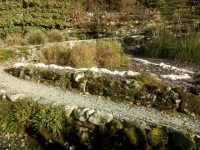 Originally constructed to introduce terracing into English Mountain cultivation, Ruskin had ambitions for a garden that was, to put it mildly, wildly different from the conventional run of Victorian landscapes. In the Zig-Zaggy, Ruskin created a garden that reflected the Purgatorial Mount in Dante’s ‘Divine Comedy’. And what might that look like? Now it has been reconstructed, it takes the form of an allegory of the Seven Deadly Sins. Entering from the bottom the
Originally constructed to introduce terracing into English Mountain cultivation, Ruskin had ambitions for a garden that was, to put it mildly, wildly different from the conventional run of Victorian landscapes. In the Zig-Zaggy, Ruskin created a garden that reflected the Purgatorial Mount in Dante’s ‘Divine Comedy’. And what might that look like? Now it has been reconstructed, it takes the form of an allegory of the Seven Deadly Sins. Entering from the bottom the 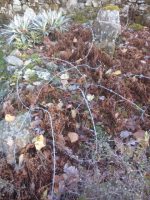 visitor climbs the terraces passing as they do envy (with barbed wire as part of the planting scheme),
visitor climbs the terraces passing as they do envy (with barbed wire as part of the planting scheme), pride, sloth, anger, gluttony and avarice, topping it off with lust. It is certainly an interesting idea, though whether it works is perhaps difficult to be sure in November when the luxuriant planting has wilted in the autumn frosts. Love in a cold climate perhaps. But lust? Perhaps best left for a sultry summer afternoon.
pride, sloth, anger, gluttony and avarice, topping it off with lust. It is certainly an interesting idea, though whether it works is perhaps difficult to be sure in November when the luxuriant planting has wilted in the autumn frosts. Love in a cold climate perhaps. But lust? Perhaps best left for a sultry summer afternoon.
October 11, 2018
It was 24 deg C yesterday, 10 October. I spent most of the day outdoors walking the north Oxfordshire countryside with friends from the residents association walking group and getting a tan. Yes really; it was that warm. We have had hot summers before; everybody who is old enough harks back to 1976 which I remember well as it was the year of my finals. I spent much of the summer working on building sites, installing a village sewerage system – and getting a tan into the bargain. But this summer has gone on so long. And the effects in the garden have been dramatic. Huge cracks in the lawn and garden beds, fruit trees clearly under stress – I’ve never watered fruit trees to keep them alive before – shrubs and ornamental grasses dying. This despite a good system of mulching, composting and rainwater harvesting. Nevertheless a number of things have thrived in the hot weather, basil for example. I’ve had three crops, and made two batches of pesto one in August, one in September from the same plants. Twenty five years ago it wasn’t possible to grow basil outdoors successfully. The fig tree has produced dozens and dozens of truly delicious figs as it has done consistently since 2003 – anther pretty hot year as I recall. But this year those wee second crop figs that appear in August and never come to anything before the cold weather sets in, have flourished swelling to a size that if they ripen they will be the first ever second crop – just like in Greece or Italy. Its too early to tell whether they will ripen, but then England isn’t Greece either. Grapes too. My vine isn’t big enough yet to produce a large crop but those it did produce were delicious and my next door neighbours had so many they were handing them out to neighbours and even the builders I had doing some work last week. A cornucopia.
Twenty five years ago it wasn’t possible to grow basil outdoors successfully. The fig tree has produced dozens and dozens of truly delicious figs as it has done consistently since 2003 – anther pretty hot year as I recall. But this year those wee second crop figs that appear in August and never come to anything before the cold weather sets in, have flourished swelling to a size that if they ripen they will be the first ever second crop – just like in Greece or Italy. Its too early to tell whether they will ripen, but then England isn’t Greece either. Grapes too. My vine isn’t big enough yet to produce a large crop but those it did produce were delicious and my next door neighbours had so many they were handing them out to neighbours and even the builders I had doing some work last week. A cornucopia.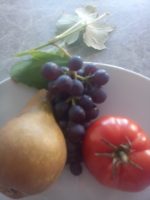
This was also the week when the UN Intergovernmental Panel on Climate Change issued its latest Report. It makes for gloomy, even alarming reading though the two upsides were that at least all the 195 countries involved signed it off including the USA, and that it stated quite clearly that keeping the Earth’s temperature rise at or below 1.5 deg C from pre-industrial levels was still do-able technically given the political will, though we have only 12 years to achieve it in. The scale of the ambition set out in the Report is huge, annual levels of investment in zero carbon infrastructure of all sorts in this country alone that would rival the defence budget ie about £50 bn a year. But yes, its not yet out of reach.
In a way gardeners are the proverbial canary in the coal mine on climate change – or as it is more accurately beginning to be referred to – climate breakdown. What is happening to agriculture world wide is felt right there at your finger tips in the garden; longer growing seasons, more water stress, (or sometimes far too much water), the impact of really burning sun on tender young plants, a sense that the rules and wisdom handed down over generations of when to plant, where and when to harvest or prune and what to grow, no longer apply, that the advice of oldsters like myself isn’t really all that useful any more. The impact on birds, animals and insects, all pretty crucial in a garden setting (let alone for global biodiversity), particularly an organic one is already very noticeable. Where are those snuffling hedgehogs? The bees? The frogs and toads are still about (thank you for eating those slugs…. ) but for how much longer as drought become more of a feature of central England gardens? Its all a bit predictable.
I remember doing a presentation on climate change in the garden for Science Oxford a decade ago when all these issues were on the horizon, and creating a ‘climate resilient’ garden was seen as a good idea but perhaps not an urgent one. A decade later and we seem to be on the brink of those changes much more quickly than I or anyone else had anticipated. A 1 deg C rise in temperature, a point we have already reached, increases the growing season in south east England by three weeks every year. Yes it was a lovely summer, indeed we are probably at that point where the benefits of a warming climate (slightly) outweigh the disadvantages. But if in fifteen years time 2018 will be seen as a ‘cool’ summer with the ‘new normal’ a lot hotter then we all, plants, animals and humans will struggle and while we grapple with the dramatic changes in lifestyle we will need to survive as a species and as a planet, we are sure going to need the shade in our gardens.
September 28, 2018
The Muck’s have been travelling. To Italy. The reason was to commemorate and honour the memory of my uncle Martin Stott who joined the Royal Marines after a year at art school in Liverpool during World War Two and was deployed first to Sicily and then to mainland Italy. He landed just north of Salerno on 9 September 1943 in a somewhat ill-fated attempt by the Allies, led by the American 5th Army, to steal a march on the Nazi’s in the disarray following the overthrow of Mussolini and the Italian change of sides in the War. Known as the Battle of Salerno it wasn’t our finest hour. Uncle Martin was a Captain in the Marines and was detailed to take a small village, Vietri just north of Salerno and secure the steep narrow valley which had the main railway line and road running through heading north to Naples.  The Germans had other ideas, and a fierce battle ensued. They captured the village but he was killed the following day aged just 22, as they tried to push on up the valley. Tracking down a memorial, exploring the valley, and examining the beach where they landed at 4am on that fateful September morning (local restaurateurs would probably charge them for the privilege if they tried it now) is emotionally draining so we took solace in one of Salerno’s greatest jewels, the Minerva Gardens. These days Salerno is a port city that the guide books describe with some justification as ‘gritty’.
The Germans had other ideas, and a fierce battle ensued. They captured the village but he was killed the following day aged just 22, as they tried to push on up the valley. Tracking down a memorial, exploring the valley, and examining the beach where they landed at 4am on that fateful September morning (local restaurateurs would probably charge them for the privilege if they tried it now) is emotionally draining so we took solace in one of Salerno’s greatest jewels, the Minerva Gardens. These days Salerno is a port city that the guide books describe with some justification as ‘gritty’.
But what a jewel the Minerva Gardens are. The Giardino della Minerva are right in the small old medieval city (an absolute undiscovered joy in itself) accessed through a wooden door in a high wall from a narrow flight of steps. Inside, the garden which is small, tumbles down a series of steep terraces – everything in the old city is steep.  It is part of a series of walled and terraced vegetable gardens climbing from the Municipal Park by the River Fusandola to the Arechi Castle. It is old, founded in the early 14C by the the medical writer and botanist Matteo Silvatico who taught at he Salerno Medical School, Europe’s oldest (it closed in the 19C). Recent excavations have found evidence of the original garden some two metres below the current surface. Silvatico cultivated some of the plants used to produce the active ingredients employed for therapeutic purposes in the medical school, ‘simples’ in the terminology of the times. This tradition continues today with the plants labelled according to the medical ‘humours’ characterised as wet, dry, hot and cold and variations across these spectrums. The gardens were set up as a charity after World War Two and restored over several years from 2000 using EU funding and the garden is complemented by a pharmacy museum opened in 2008 in the adjoining house.
It is part of a series of walled and terraced vegetable gardens climbing from the Municipal Park by the River Fusandola to the Arechi Castle. It is old, founded in the early 14C by the the medical writer and botanist Matteo Silvatico who taught at he Salerno Medical School, Europe’s oldest (it closed in the 19C). Recent excavations have found evidence of the original garden some two metres below the current surface. Silvatico cultivated some of the plants used to produce the active ingredients employed for therapeutic purposes in the medical school, ‘simples’ in the terminology of the times. This tradition continues today with the plants labelled according to the medical ‘humours’ characterised as wet, dry, hot and cold and variations across these spectrums. The gardens were set up as a charity after World War Two and restored over several years from 2000 using EU funding and the garden is complemented by a pharmacy museum opened in 2008 in the adjoining house.
We arrived rather late – detained by so many fascinating aspects of the old city, but the early evening light and September breezes were a perfect context to absorb the sounds of the complex network of fountains,  waterways and springs that keep the garden so lush, breathe in the fragrant smells of the lemon and other trees, and appreciate the amazing views over the Gulf of Salerno. Closer too are the surrounding old city buildings with balconies, windows and lines of drying washing. One neighbour watering his own garden on a terrace above managed to give Lord Muck an accidental dousing.
waterways and springs that keep the garden so lush, breathe in the fragrant smells of the lemon and other trees, and appreciate the amazing views over the Gulf of Salerno. Closer too are the surrounding old city buildings with balconies, windows and lines of drying washing. One neighbour watering his own garden on a terrace above managed to give Lord Muck an accidental dousing.
Despite the labels (mostly in Latin) identification of the plants wasn’t all that straightforward as so many grow much bigger than in England, flower at different seasons or are unfamiliar varieties. Shade isn’t just for the plants; a delightful terrace with a stunning view in front of the building housing the pharmacy museum provides refreshments including a range of herbal teas. We could have spent twice as long as we did there, but closing time beckoned so rather than tea, a quiet beer in one of the nearby bars had to suffice. A toast to uncle Martin for bringing us to this delightful spot in the first place and a touch of sadness that he never got to enjoy it himself.
June 4, 2018
Lady Muck has recently returned from a trip to Berlin to visit family, and reports that the asparagus season is in full swing there with various festivals and events to celebrate its joys. Of course being spring time the rather obviously phallic shape of the spears has certain fertility connotations, but what I hadn’t realised is that its popularity in Berlin and that eastern part of Germany is at least in part a reaction to it being very much disapproved of in the old GDR where it was denounced as a ‘bourgeois vegetable’. Cultivation being pretty much banned until 1990 (doubtless there were a few fields where it was grown for the delectation of ‘leading Party members’ who could be relied upon never to fall for bourgeois delights of any kind) the joy of being able to eat it without restriction subsequently, must have made the pleasure all the sweeter. It is a useful coincidence that the flat fertile farmland immediately to the south of Berlin, stretching out towards Wittenberg, is peculiarly suitable for its cultivation. Actually come to think of it, Martin Luther might have had a word or two to say about its cultivation too, and for not entirely different reasons than those of Party officials in the GDR 450 years later.
My friend Gunter, a long time Berlin resident tells me that back in the day Agriculture Ministry officials in the GDR, really divided up vegetable growing into those that could be produced on a large scale – suitable both for collective farms, and for mechanisation, and those like asparagus, that couldn’t. Naturally potatoes were an approved proletarian vegetable. More surprisingly so too was rhubarb. So much so that in the GDR rhubarb was more popular than potatoes (surely not as an accompaniment to fish!). But irony of ironies,  rhubarb was very difficult to obtain in bourgeois West Germany and the souvenir of choice for west Berliners returning from a day trip to the East in those days was a supply of bottles of rhubarb juice, completely unobtainable in the West. Gunter still has some souvenir bottles – the genuine stuff from the GDR days, in his memorabilia collection.
rhubarb was very difficult to obtain in bourgeois West Germany and the souvenir of choice for west Berliners returning from a day trip to the East in those days was a supply of bottles of rhubarb juice, completely unobtainable in the West. Gunter still has some souvenir bottles – the genuine stuff from the GDR days, in his memorabilia collection.
April 16, 2018
It has taken quite a while for Spring to arrive this year – just in the past few days really. And while I’ve been sitting at home watching the rain pour out of the sky and taking occasional forays into the garden to see how the new hens, Tolstoy and Kropotkin are settling in, to paddle on the flooded lawn, or take dispiriting trips down to the allotment to observe the devastation, I’ve had plenty of time to reflect on allotment years past. In doing so I realised that it is 30 years since I took on my plot on Bartlemas Close. Not the first allotment I have ever had, but by far the longest in one place, and the one to which I am still attached. Casting back all those years certainly brings back a host of memories. It was the early spring of 1988 when the call came from Mike, field secretary to say a plot had come free and did I want it. We had moved into our house on Divinity Road a couple of months earlier, were in the throes of renovation, a new roof in December (yes really) an extension about to start, a new baby on the way – Nadine arrived in mid-March, and major commitments both as a City councillor for the area and in my job as Co-op development worker for Oxfordshire. No pressure then. But growing has been a central part of my life since childhood so there was no way I would turn down such an offer on a site just five minutes from my new house.
I don’t remember that much about the first months apart from getting a shed down there; the ground was so frozen that the shed could be lifted whole on to the back of a flat-bed truck and transported right to its final resting place at the back of the allotment, no crops in in the way and no chance of getting stuck in mud. The shed is still in use. The only other memory of ‘the plot as first seen’, was the unpleasant discovery of just how much couch grass there was on it. It is my fellow plot holders though that made those first few months down there with a new-born baby such a pleasure. My immediate plot neighbours, Chris Kingston from Ireland and Laurie Spencer from Barbados, both sadly no longer with us were a source of fellowship, good advice and ideas for vegetables and growing techniques I hadn’t come across before. Chris, far older than me but built like an ox was only too happy to help out digging over my plot when I thought the couch grass would get the better of me.
For several years that plot was a one of the fixed points around which my life revolved. Close to home, it was absolutely ideal for escaping the pressures of work and council life. Secure, rustic, rural even, it was a heaven for small children; there were plenty of others down there to play with, there was plenty of mud and water to get thoroughly messy in, there were dens to be made, wildlife to be discovered, field mouse nests, birds nests, hedgehogs, ants and woodlice, rabbit and deer tracks to follow, occasionally fires to be lit, ‘assistance’ to be given to daddy, and depending on the season, produce to be picked and eaten. ‘Green sweeties’ – peas straight out of the pod were a particular favourite and later in the season, raspberries and blackberries. Whole days could be and were spent happily down there with a picnic, quite often with visitors such as grandparents. A ten pole plot didn’t seem such a challenge when time was on your side.
With familiarity came a certain confidence – not just in growing, the plot with others on the site was opened to the public as part of an HDRA (now Garden Organic) ‘open gardens’ event for a couple of years and attracted the local television channel to the site, but also photographically. Allotment sites are an absolute joy to photograph; their quirkiness (both plot holders and their produce), their traditions, their informality, their provisional ‘edgeland’ nature, cold frames, irrigation systems, sheds… the opportunities were endless and by the end of 1990 I had amassed a collection of pictures, starring both Laurie and Chris as well as Mike gleaning cherry tomatoes with a gang of children, which on 2 January 1991 opened as an exhibition at the Photographers Workshop entitled ‘Earthly Paradise: people and landscapes on allotments.’ The exhibition toured widely that year; to local swimming pools and leisure centres, doctors surgeries and other allotment sites, and was picked up by the late great Roger Deakin with a number of the pictures being used in his Anglia TV programme ‘The ballad of the ten rod plot’ (‘…a wonderful little film’, Robert Macfarlane) broadcast in 1992. My goodness, just writing this makes me realise just how much joy and creativity came from that little patch of land. Far too much for a single blog.
January 29, 2018
I killed my hens a few days ago. I’m not in the habit of doing this;  I’m very fond of hens and have been keeping them for getting on for 20 years (and indeed kept them as a child), but if you look after them properly they grow old and stop laying eggs. Actually that isn’t quite true. The first hens I had were Warrens the breed created for the intensive laying industry. They are pretty easy to obtain and they are bred to lay and lay and lay for a couple of years and then die. That’s the economic model of the industry. Why pay for the feed and housing of hens that don’t lay? Being new to the game I didn’t know this when I got them. When they predictably, died, I got some pure breeds, a White Sussex a Barred Plymouth Rock and a Rhode Island Red from memory. They were lovely and lived to a great age, ten, not laying an egg between them for about the last two years of their lives and only about 50-60 a year for a couple of years before that. Actually they might well have lived a while longer, but they made the ultimate sacrifice and final contribution to the household economy and after I’d killed them they ended up in the pot. So most recently in 2012 I set off again to the Domestic Fowl Trust then still based outside Pershore for three more. These were crosses of various kinds including a Speckeldy, some kind of Plymouth Rock cross and some kind of Sussex. Six years later the time came round again for the killing spree. No eggs laid since about September and no sign despite the lengthening days, of any more to come. Two more (the third one died about three years ago after being severely frightened by a fox) to add to the statistics – which in the UK alone is in excess of 600 million hens a year slaughtered – yes really. That statistic kind of summarises my position on this. As a vegetarian for the past almost 40 years I’d be a lot a happier about meat eating if people slaughtered it themselves (road kill allowed). I think that might reduce meat consumption quite a bit, helping both the planet and peoples wallets and carbon footprint. To say nothing of animal welfare. But I digress.
I’m very fond of hens and have been keeping them for getting on for 20 years (and indeed kept them as a child), but if you look after them properly they grow old and stop laying eggs. Actually that isn’t quite true. The first hens I had were Warrens the breed created for the intensive laying industry. They are pretty easy to obtain and they are bred to lay and lay and lay for a couple of years and then die. That’s the economic model of the industry. Why pay for the feed and housing of hens that don’t lay? Being new to the game I didn’t know this when I got them. When they predictably, died, I got some pure breeds, a White Sussex a Barred Plymouth Rock and a Rhode Island Red from memory. They were lovely and lived to a great age, ten, not laying an egg between them for about the last two years of their lives and only about 50-60 a year for a couple of years before that. Actually they might well have lived a while longer, but they made the ultimate sacrifice and final contribution to the household economy and after I’d killed them they ended up in the pot. So most recently in 2012 I set off again to the Domestic Fowl Trust then still based outside Pershore for three more. These were crosses of various kinds including a Speckeldy, some kind of Plymouth Rock cross and some kind of Sussex. Six years later the time came round again for the killing spree. No eggs laid since about September and no sign despite the lengthening days, of any more to come. Two more (the third one died about three years ago after being severely frightened by a fox) to add to the statistics – which in the UK alone is in excess of 600 million hens a year slaughtered – yes really. That statistic kind of summarises my position on this. As a vegetarian for the past almost 40 years I’d be a lot a happier about meat eating if people slaughtered it themselves (road kill allowed). I think that might reduce meat consumption quite a bit, helping both the planet and peoples wallets and carbon footprint. To say nothing of animal welfare. But I digress.
My friend Premier came round to help. She was originally from Zimbabwe and learned to slaughter, pluck, gut and joint chickens from the age of ten. So she knew what to do. We killed one each. Pretty quick, pretty easy, but her method was more elegant. My experience is just once every 5-6 years. Mind you the phrase ‘headless chicken’ hasn’t passed into the language for no reason. They really do flap around, and if you gave them the chance, run about for a good minute or so. Stone dead, but looking alarmingly alive. Prepping them up for the pot was an eye opener – I’ve always avoided this part of the process in the past. Plucking is made much easier by pouring very hot water over them – the feathers come out real easy then (actually I knew this part as I’d read about it in novels like Edna O’Brien’s ‘The country girls’ – life in the west of Ireland in the 1950’s). Gutting them is a real skill; I wasn’t going anywhere near this part, definitely not ‘Blue Peter’ try-this-one-at-home style. Premier managed to extract all the offal and separated it away for consumption; heart, liver, kidney, gizzard, the lot, with of course the sole exception of the gall bladder which she carefully cut out – bursting that and you spoil the lot. Then to the jointing. Even here nothing is lost. The legs are descaled, and the feet are removed and kept – presumably for soup, there isn’t anything else on them. Ditto the head. Bones are broken and legs, wings and rib cage are reduced to manageable sizes.
My experience is just once every 5-6 years. Mind you the phrase ‘headless chicken’ hasn’t passed into the language for no reason. They really do flap around, and if you gave them the chance, run about for a good minute or so. Stone dead, but looking alarmingly alive. Prepping them up for the pot was an eye opener – I’ve always avoided this part of the process in the past. Plucking is made much easier by pouring very hot water over them – the feathers come out real easy then (actually I knew this part as I’d read about it in novels like Edna O’Brien’s ‘The country girls’ – life in the west of Ireland in the 1950’s). Gutting them is a real skill; I wasn’t going anywhere near this part, definitely not ‘Blue Peter’ try-this-one-at-home style. Premier managed to extract all the offal and separated it away for consumption; heart, liver, kidney, gizzard, the lot, with of course the sole exception of the gall bladder which she carefully cut out – bursting that and you spoil the lot. Then to the jointing. Even here nothing is lost. The legs are descaled, and the feet are removed and kept – presumably for soup, there isn’t anything else on them. Ditto the head. Bones are broken and legs, wings and rib cage are reduced to manageable sizes.  Thirty minutes or so later there was 2.5kg of edible (in one form or another) chicken from each bird and waste amounting to half a cup full from the pair of them. Now that is the way to honour their lives. Thank you dear hens; you were great company, an ornament in the garden, delightfully productive in your lives, and equally so in your deaths. May your souls soar and when I come to eat you I will raise a glass to your memory.
Thirty minutes or so later there was 2.5kg of edible (in one form or another) chicken from each bird and waste amounting to half a cup full from the pair of them. Now that is the way to honour their lives. Thank you dear hens; you were great company, an ornament in the garden, delightfully productive in your lives, and equally so in your deaths. May your souls soar and when I come to eat you I will raise a glass to your memory.
 The first impression is of vertiginously steep sides to the grass-covered crater which had recently been mown. Second impression is that there are some pretty large holes in the turf. The Irish climate is a lot wetter than Arizona and this may not have been accounted for in the design. There is a sense of the steep sides slipping towards the centre of the crater with the passage of time and the depredations of the elements. In the centre is a plinth made from black granite. It is designed for two people to lie on (no, not making love) toe-to-toe, head resting on a small granite pillow below the level of the rest of the body. Open your eyes and look up.
The first impression is of vertiginously steep sides to the grass-covered crater which had recently been mown. Second impression is that there are some pretty large holes in the turf. The Irish climate is a lot wetter than Arizona and this may not have been accounted for in the design. There is a sense of the steep sides slipping towards the centre of the crater with the passage of time and the depredations of the elements. In the centre is a plinth made from black granite. It is designed for two people to lie on (no, not making love) toe-to-toe, head resting on a small granite pillow below the level of the rest of the body. Open your eyes and look up.  The view is disorientating. Almost at the edge of the field of view is the top of the crater and above, the sky. On a clear night the view would be stunning – the sky a myriad of bright stars and celestial objects, framed by the blackness of the grass crater. On a sunny day the patterns of clouds and their ever-shifting configurations would be a joy to behold – though not that different from lying flat on a sloping beach. But today the sky was uniformly grey; more Skegness from a bus shelter on the prom in mid-February than a mystical revelation on the edge of the Sahara at night. Nonetheless we stayed and stared.
The view is disorientating. Almost at the edge of the field of view is the top of the crater and above, the sky. On a clear night the view would be stunning – the sky a myriad of bright stars and celestial objects, framed by the blackness of the grass crater. On a sunny day the patterns of clouds and their ever-shifting configurations would be a joy to behold – though not that different from lying flat on a sloping beach. But today the sky was uniformly grey; more Skegness from a bus shelter on the prom in mid-February than a mystical revelation on the edge of the Sahara at night. Nonetheless we stayed and stared.






















